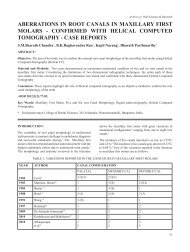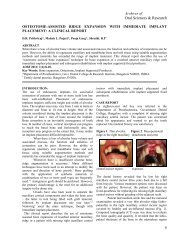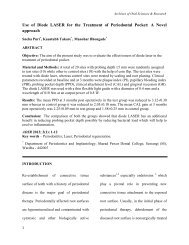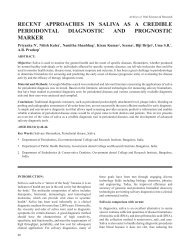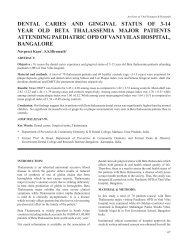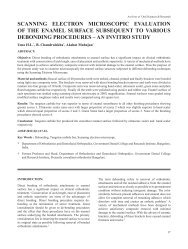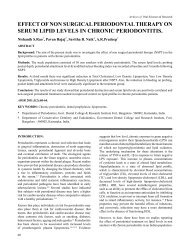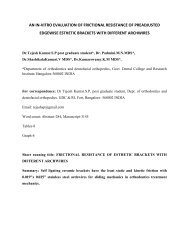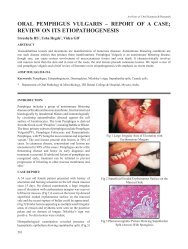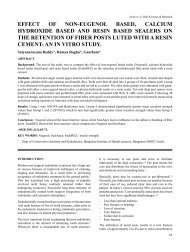missing tooth tissue replacementâthe milestones- a ... - Aosr.co.in
missing tooth tissue replacementâthe milestones- a ... - Aosr.co.in
missing tooth tissue replacementâthe milestones- a ... - Aosr.co.in
Create successful ePaper yourself
Turn your PDF publications into a flip-book with our unique Google optimized e-Paper software.
MISSING TOOTH TISSUE REPLACEMENT—THE<br />
MILESTONES- A REVIEW<br />
Sahana N S * , Sr<strong>in</strong>ath S K † , S Hemavathy * , Vishwanath S K ‡<br />
ABSTRACT:<br />
Objective: This review focuses on past, recent and promis<strong>in</strong>g developments <strong>in</strong> the fields of <strong>tooth</strong> replacements that are of<br />
particular relevance for dental <strong>tissue</strong> and whole-<strong>tooth</strong> regeneration. Here the literature perta<strong>in</strong><strong>in</strong>g to different methods used to<br />
replace the <strong>miss<strong>in</strong>g</strong> <strong>tooth</strong> <strong>tissue</strong> were <strong>co</strong>mpiled and reviewed.<br />
Material and Methods: Relevant literature <strong>co</strong>ncerned with <strong>tooth</strong> <strong>tissue</strong> replacement <strong>in</strong> the past as well as the recent ongo<strong>in</strong>g<br />
research work on <strong>tooth</strong> <strong>tissue</strong> regeneration were searched <strong>in</strong> the Google/Medl<strong>in</strong>e and 53 articles were reviewed, analyzed and<br />
<strong>co</strong>mpiled <strong>in</strong> this article.<br />
Conclusion: In the last decade, significant advances have been made <strong>in</strong> approaches used to replace <strong>miss<strong>in</strong>g</strong> teeth. As adult<br />
<strong>tissue</strong> derived cell sources are anticipated to be useful <strong>in</strong> cl<strong>in</strong>ical applications for <strong>tooth</strong> regeneration, several stem cells/<br />
progenitor cells have been found, which were isolated from adult dental/non-dental <strong>tissue</strong>s. The future for regenerative and<br />
<strong>tissue</strong>-eng<strong>in</strong>eer<strong>in</strong>g applications to dentistry is one with immense potential, capable of br<strong>in</strong>g<strong>in</strong>g quantum advances <strong>in</strong> treatment<br />
for our patients. With today’s 21st century technological advancements, it is expected that <strong>in</strong>dividuals will either reta<strong>in</strong> their<br />
natural teeth or obta<strong>in</strong> functional <strong>tooth</strong> replacements throughout their entire life. Even though the <strong>tooth</strong> regeneration looks<br />
exit<strong>in</strong>g many hurdles must be over<strong>co</strong>me to develop <strong>tooth</strong> regenerative therapy <strong>in</strong> humans and reviews regard<strong>in</strong>g the <strong>tooth</strong><br />
regeneration processes must be wel<strong>co</strong>me.<br />
AOSR 2012;2(1):47-52.<br />
Key Words: Dentures, Implants, Transplantations, <strong>tooth</strong> regeneration, Scaffolds, Cell aggregate methods.<br />
* Department of Oral Pathology, Government Dental College and Research Institue, Bangalore, India.<br />
† Department of Pedodontics, Government Dental College and Research Institue, Bangalore, India.<br />
‡ Department of Prosthodontics, Government Dental College and Research Institue, Bangalore, India.<br />
Archives of Oral Sciences & Research<br />
INTRODUCTION:<br />
The Teeth are highly m<strong>in</strong>eralized appendages found <strong>in</strong> the<br />
entrance of the alimentary canal of both <strong>in</strong>vertebrates and<br />
vertebrates, first appeared at Ordovicium, approximately<br />
460 million years ago. Some jawless fish developed<br />
superficial, dermal structures known as odontodes 1-3<br />
which were located outside the mouth. The encroachment<br />
of odontodes <strong>in</strong>to the oropharyngeal cavity created the<br />
buccal teeth, which <strong>co</strong>vered the entire surface and later<br />
were localized to the jaw marg<strong>in</strong>s. 4<br />
The WHO World Oral Health Report 2003 identified caries<br />
as a <strong>co</strong>nt<strong>in</strong>u<strong>in</strong>g global problem, with an estimated five<br />
billion people worldwide hav<strong>in</strong>g experienced the disease. 5<br />
Tooth loss is an early <strong>in</strong>dicator of accelerated ag<strong>in</strong>g.<br />
Edentulism not only results <strong>in</strong> reduced oral and social<br />
functions but also rema<strong>in</strong>s a major public health issue. 6<br />
In the last decade, significant advances have been made <strong>in</strong><br />
approaches used to replace <strong>miss<strong>in</strong>g</strong> teeth. 7<br />
Milestone:<br />
The earliest dental material science began <strong>in</strong> the laboratory<br />
of G.V. Black at Northwestern University <strong>in</strong> 1900. 8 A major<br />
<strong>co</strong>ncentration has been <strong>in</strong> the area of dental materials used<br />
to restore <strong>tooth</strong> structure, fabrication of crowns, dentures,<br />
partials, and other restorative approaches and also <strong>in</strong><br />
improvements <strong>in</strong> the design of materials used to restore<br />
teeth/periodontium/bone lost as a <strong>co</strong>nsequence of disease<br />
or disorders. 9 While these synthetic materials post various<br />
degrees of success, they bear little resemblance to the<br />
enamel <strong>tissue</strong> <strong>in</strong> their chemical and structural makeup. 7<br />
History of Dentures starts way back. Around 700BC,<br />
Etruscans <strong>in</strong> northern Italy made dentures out of human<br />
or other animal teeth. 10 Dentures can be either partial or<br />
<strong>co</strong>mplete.<br />
Partial dentures are for patients who are <strong>miss<strong>in</strong>g</strong> some of<br />
their teeth on a particular arch and are made from crowns<br />
that resemble the <strong>miss<strong>in</strong>g</strong> teeth which are fitted on the<br />
47
Sahana N S et al.<br />
rema<strong>in</strong><strong>in</strong>g teeth to act as abutments and pontics . Fixed<br />
bridges are more expensive than removable appliances but<br />
are more stable. 3<br />
Complete dentures are worn by patients who are <strong>miss<strong>in</strong>g</strong><br />
all of the teeth <strong>in</strong> a s<strong>in</strong>gle arch. The oldest <strong>co</strong>mplete denture<br />
appeared <strong>in</strong> Japan, and it was a wooden denture. Laterthe<br />
porcela<strong>in</strong> dentures were made around 1770 Then<strong>in</strong> 1820<br />
dentures were mounted on 18 carat gold plates, later from<br />
vulcanite, <strong>in</strong> 20th century- acrylic res<strong>in</strong> and other plastics.<br />
Complete denture therapy, is associated with <strong>co</strong>mplications<br />
such as denture-<strong>in</strong>duced stomatitis, soft <strong>tissue</strong> hyperplasia,<br />
traumatic ulcers, altered taste perception and burn<strong>in</strong>g<br />
mouth syndrome. 11 Therefore, the need for alternative<br />
<strong>tooth</strong> replacement therapies is quite evident. 12<br />
Implants carry a success rate of around 95% over 15 years,<br />
which makes dental implants the most popular method for<br />
replac<strong>in</strong>g a <strong>miss<strong>in</strong>g</strong> <strong>tooth</strong> at the present time. 12 However,<br />
osseo<strong>in</strong>tegration represents a direct <strong>co</strong>nnection between<br />
the implant and bone <strong>tissue</strong> and lacks the periodontium<br />
and cementum <strong>tissue</strong>s present <strong>in</strong> naturally formed teeth,<br />
which function to cushion and modulate the mechanical<br />
stress of mastication. Therefore, strategies to generate<br />
dental implants with associated periodontal <strong>tissue</strong>s have<br />
be<strong>co</strong>me a new approach <strong>in</strong> <strong>tooth</strong> replacement therapies. 12-15<br />
The first transplantation attempts were made without<br />
any knowledge of the species barrier. The pioneers of<br />
xenotransplantation realized xenotransfusions as early as<br />
the 16th century. 16 Transplantation can be of two types;<br />
Allotransplantation and Autotransplantation. 17<br />
Allotransplantation of teeth is mov<strong>in</strong>g teeth from one<br />
person to other .The earliest reports of <strong>tooth</strong> transplantation<br />
<strong>in</strong>volve slaves <strong>in</strong> ancient Egypt who were forced to give<br />
up their teeth to the pharaohs. 18 There are reports of<br />
men scaveng<strong>in</strong>g the aftermaths of battlefields dur<strong>in</strong>g the<br />
Napoleonic wars, <strong>co</strong>llect<strong>in</strong>g the choicest teeth from the<br />
fallen soldiers <strong>in</strong> the hopes of us<strong>in</strong>g them <strong>in</strong> other mouths. 19<br />
It <strong>co</strong>nt<strong>in</strong>ued for many centuries till <strong>in</strong> the late 18th century,<br />
physicians observed that <strong>co</strong>ntagious diseases, especially<br />
syphilis, spread among the recipients of <strong>tooth</strong> transplants,<br />
which caused allotransplantation of teeth to wane. 18,20,21<br />
The autotransplantation of teeth is mov<strong>in</strong>g a <strong>tooth</strong> from<br />
one site to another <strong>in</strong> the same <strong>in</strong>dividual. However, auto<br />
transplantation, has reported three to five-year success<br />
rates of 75 percent or more. Third molars and premolars<br />
extracted for orthodontic reasons are most <strong>co</strong>mmonly<br />
used as the donor teeth for auto transplantation 18 and<br />
is an e<strong>co</strong>nomically feasible cl<strong>in</strong>ical therapy, and teeth<br />
exhibit<strong>in</strong>g two-thirds root formation are <strong>co</strong>nsidered to<br />
be ideal for reimplantation. 22 Another advantage of <strong>tooth</strong><br />
transplantation is the possibility for pulp regeneration,<br />
revascularization, and re<strong>in</strong>nervation. The limited supply<br />
of available donor teeth restricts the practical use of this<br />
technique. 21,23<br />
Tooth autotransplantation, allotransplantation, substitut<strong>in</strong>g<br />
the lost physiological <strong>tissue</strong>/organ with a nonbiological,<br />
artificial material and dental implants have existed for<br />
many years, but have never been totally satisfactory 24<br />
and pathological repeats are <strong>co</strong>mmon. 25,26 Therefore, an<br />
ambitious dream of numerous dentists is to be able to<br />
substitute the artificial material with a biological, cell-based<br />
one that is able to form a genu<strong>in</strong>e replica of the damaged<br />
<strong>tooth</strong> part or the entire lost <strong>tooth</strong>. 3<br />
Charles L<strong>in</strong>dbergh was one of the first persons to beg<strong>in</strong><br />
to th<strong>in</strong>k about cultur<strong>in</strong>g organs. 27 By the early 1970s, the<br />
term "biomaterials" became prom<strong>in</strong>ent. Despite <strong>co</strong>nt<strong>in</strong>ual<br />
discussions about refocus<strong>in</strong>g the field of biomaterials, the<br />
greatest impetus for change did not arrive until the de<strong>co</strong>d<strong>in</strong>g<br />
of the human genome at the end of the last century. 8<br />
TISSUE ENGINEERING:<br />
In the late 1980s, a polymer chemist (Robert Langer) and<br />
the organ transplant surgeon (Joseph Vacanti) proposed that<br />
it might be possible to generate a <strong>tissue</strong> or organ by seed<strong>in</strong>g<br />
the cells that make this <strong>tissue</strong> <strong>in</strong>to a biodegradable scaffold.<br />
This approach to regenerative medic<strong>in</strong>e was named <strong>tissue</strong><br />
eng<strong>in</strong>eer<strong>in</strong>g, which is def<strong>in</strong>ed as an <strong>in</strong>terdiscipl<strong>in</strong>ary field<br />
that applies the pr<strong>in</strong>ciples of eng<strong>in</strong>eer<strong>in</strong>g and the life<br />
sciences toward biological substitutes that restore, ma<strong>in</strong>ta<strong>in</strong><br />
or improve <strong>tissue</strong> function. 5<br />
PARTIAL TOOTH TISSUE REGENERATION:<br />
Over the last few years, dental researchers started to explore<br />
the potential of <strong>tissue</strong> eng<strong>in</strong>eer<strong>in</strong>g to repair lost <strong>tooth</strong><br />
structures and, perhaps, even for <strong>co</strong>mplete replacement of<br />
an entire <strong>tooth</strong>. 28 The po<strong>in</strong>t of <strong>in</strong>terest is that various animal<br />
species (e.g., mice) can replace physically worn teeth parts<br />
of vary<strong>in</strong>g teeth types with stem cells 29,30 and numerous<br />
animals are endowed with the ability to <strong>co</strong>nt<strong>in</strong>ually replace<br />
lost teeth throughout life via de novo formation of <strong>tooth</strong><br />
germs (polyphyodonty). 31 Normally, humans do not have<br />
such abilities; however, it is possible that the regenerative<br />
potential <strong>in</strong> humans is underestimated and some of<br />
<strong>co</strong>mponents might be able to be reactivated under certa<strong>in</strong><br />
circumstances. 3,27,32<br />
Nearly every organ harbors <strong>in</strong> particular niches specific<br />
cells that are known today as somatic stem cells. 3,29,33-35 The<br />
ability of human teeth to form reparative dent<strong>in</strong> <strong>in</strong> response<br />
to deep caries and mild trauma suggests that progenitor<br />
cells present <strong>in</strong> fully developed <strong>tooth</strong> pulp reta<strong>in</strong> the ability<br />
to form functional odontoblasts, which can produce dent<strong>in</strong>like<br />
hard <strong>tissue</strong>s. 36 This l<strong>in</strong>e of research seeks to reactivate<br />
exist<strong>in</strong>g but latent reparative capabilities and/or use teethrelated<br />
stem cells to repair the damaged part of the <strong>tooth</strong><br />
by cell multiplication and production of the <strong>miss<strong>in</strong>g</strong><br />
material, 17 <strong>in</strong> attempts to repair the damaged <strong>tissue</strong>s like<br />
pulp and dent<strong>in</strong>. 7,37 In an effort to restore periodontal <strong>tissue</strong>s,<br />
48
Tooth Tissue Replacement<br />
Guided <strong>tissue</strong> regeneration was successfully used. 38<br />
To <strong>in</strong>crease bone at a specific site, <strong>in</strong>clud<strong>in</strong>g sites for<br />
implantation of teeth, various barrier membranes often<br />
<strong>co</strong>upled with grafts/polymers/factors, etc. have been used<br />
with vary<strong>in</strong>g success. 7<br />
dissociated from both the epithelium and the mesenchyme,<br />
and the <strong>co</strong>rrect placement of cells is a major issue 46<br />
(fig.1).<br />
The more long-term branch of research <strong>in</strong>volves us<strong>in</strong>g<br />
stem cells and apply<strong>in</strong>g <strong>co</strong>nventional <strong>tissue</strong> eng<strong>in</strong>eer<strong>in</strong>g<br />
techniques to create a replica of the desired <strong>miss<strong>in</strong>g</strong><br />
<strong>tooth</strong>. 7<br />
WHOLE TOOTH REGENERATION:<br />
Numerous studies <strong>in</strong> the early twentieth century developed<br />
techniques for cultur<strong>in</strong>g both isolated dental <strong>tissue</strong>s and<br />
whole teeth, establish<strong>in</strong>g the basis for future experimental<br />
manipulation of dental <strong>tissue</strong>s. 7 The emergence of whole<strong>tooth</strong><br />
<strong>tissue</strong> was made possible by the marriage of biological,<br />
developmental and material sciences. 12,39 Regenerat<strong>in</strong>g a<br />
whole <strong>tooth</strong> is no less <strong>co</strong>mplicated than rebuild<strong>in</strong>g a whole<br />
heart, says Songtao Shi of the University of Southern<br />
California. 40<br />
In <strong>co</strong>nsider<strong>in</strong>g the future, several l<strong>in</strong>es of evidence need to<br />
be <strong>co</strong>nsidered: A.Enamel organ epithelia and dental papilla<br />
mesenchyme <strong>tissue</strong>s <strong>co</strong>nta<strong>in</strong>s stem cells dur<strong>in</strong>g postnatal<br />
stages of life, B.Late cap stage and bell stage <strong>tooth</strong> organs<br />
<strong>co</strong>nta<strong>in</strong> stem cells, C.O dontogenic adult stem cells responds<br />
to mechanical as well as chemical signals , D. Adult bone<br />
marrow as well as dental pulp <strong>tissue</strong>s <strong>co</strong>nta<strong>in</strong> odontogenic<br />
stem cells and Epithelial-mesenchymal <strong>in</strong>teractions are<br />
pre-requisite for <strong>tooth</strong> regeneration. 41<br />
Several populations of dental stem cells have been<br />
identified and characterized: 12 (DPSCs) Human dental pulp<br />
stem cells, 42,43 (SHED) Stem cells harvested from human<br />
exfoliated deciduous teeth, 12 (SCAP) Stem cells isolated<br />
from human teeth at the <strong>tooth</strong> root apex called DSCs of<br />
the apical papilla .<br />
At present the only human source is the <strong>tooth</strong> germ of<br />
young children. 3 Recently, dental <strong>tissue</strong> stem/progenitor<br />
cells, which can differentiate <strong>in</strong>to dental cell l<strong>in</strong>eages,<br />
have been identified <strong>in</strong> both impacted and erupted human<br />
teeth, and these cells can be used to regenerate some dental<br />
<strong>tissue</strong>s. Us<strong>in</strong>g a patient’s own stem cells avoids issues of<br />
histo<strong>co</strong>mpatability. 44<br />
Key elements:Regenerative treatments require the three<br />
key elements; an extracellular matrix scaffold, progenitor/<br />
stem cells, and <strong>in</strong>ductive morphogenetic signals. 9<br />
Recent breakthroughs <strong>in</strong> s<strong>in</strong>gle cell manipulation methods<br />
for the re<strong>co</strong>nstitution of bioeng<strong>in</strong>eered <strong>tooth</strong> germ and the<br />
<strong>in</strong>vestigation of <strong>in</strong> vivo development of artificial <strong>tooth</strong><br />
germ <strong>in</strong> the adult oral environment have been reported. 45<br />
Re<strong>co</strong>nstitution of bioeng<strong>in</strong>eered <strong>tooth</strong> germ, like that for<br />
other organs, requires that s<strong>in</strong>gle cells are <strong>co</strong>mpletely<br />
Fig. 1: S<strong>in</strong>gle cell manipulation (Courtesy. 2009 Takashi<br />
Tsuji Laboratory) 53<br />
Fig. 2: Strategies for build<strong>in</strong>g a bioeng<strong>in</strong>eered <strong>tooth</strong> from<br />
dissociated s<strong>in</strong>gle cells. (Courtesy of Kazuhisa Nakao,<br />
Takashi Tsuji November 2008) 44<br />
APPROACHES FOR RECONSTRUCTION OF<br />
TOOTH:<br />
Currently, two approaches are be<strong>in</strong>g <strong>in</strong>vestigated for<br />
re<strong>co</strong>nstruct<strong>in</strong>g teeth us<strong>in</strong>g cell culture procedures. One<br />
approach is to seed <strong>tooth</strong> germ cells <strong>in</strong>to <strong>tooth</strong>-shaped<br />
scaffolds made of bio degradable materials. The other<br />
approach is to re<strong>co</strong>nstitute teeth by reaggregat<strong>in</strong>g <strong>tooth</strong> germ<br />
from dissociated s<strong>in</strong>gle epithelial cells and mesenchymal<br />
cells. 46<br />
SCAFFOLDING METHOD:<br />
One of the three-dimensional <strong>tissue</strong> eng<strong>in</strong>eer<strong>in</strong>g methods<br />
is scaffold<strong>in</strong>g, <strong>in</strong> which a <strong>co</strong>mplex cell mixture and a<br />
prefabricated biodegradable scaffold are employed to<br />
grow a <strong>tissue</strong> of a desired form 47 (fig.2). The importance<br />
49
Sahana N S et al.<br />
of scaffold materials and design for <strong>tissue</strong> eng<strong>in</strong>eer<strong>in</strong>g has<br />
long been re<strong>co</strong>gnized. Scaffold porosity, bio<strong>co</strong>mpatibility<br />
and biodegradability, the ability to support cell growth,<br />
and use as a <strong>co</strong>ntrolled gene and prote<strong>in</strong> delivery vehicle<br />
are all highly significant properties. 48 The different<br />
scaffold materials used are <strong>co</strong>llagen sponge, hydrophilic<br />
polymers, poly-L-lactic acid and poly lactic <strong>co</strong>-gly<strong>co</strong>lic<br />
acid <strong>co</strong>-polymers, alg<strong>in</strong>ate, and agarose and natural silk<br />
47, 49-51<br />
prote<strong>in</strong>s.<br />
Tissue eng<strong>in</strong>eer<strong>in</strong>g methods us<strong>in</strong>g scaffold should be<br />
utilized for the formation of differentiated <strong>tooth</strong> or <strong>tooth</strong><br />
germ <strong>in</strong> late stages of differentiation which has cell<br />
polarization of m<strong>in</strong>eralized <strong>tissue</strong>, and <strong>in</strong> odontoblast/<br />
ameloblast cell l<strong>in</strong>eages <strong>in</strong> organ architecture, because<br />
they can manipulate a spatial <strong>co</strong>nfiguration of several<br />
types of cells and scaffolds 47 .Arrang<strong>in</strong>g epithelial cells<br />
and mesenchymal cells with<strong>in</strong> the scaffold by seed<strong>in</strong>g<br />
them sequentially, <strong>in</strong>stead of the <strong>co</strong>nventional method of<br />
seed<strong>in</strong>g a mixture of epithelial cells and mesenchymal<br />
cells, improved the <strong>tissue</strong> arrangement <strong>in</strong> bioeng<strong>in</strong>eered<br />
teeth. 52<br />
Yelick’s 12 group exam<strong>in</strong>ed explants <strong>co</strong>nta<strong>in</strong><strong>in</strong>g dissociated<br />
cells isolated from porc<strong>in</strong>e unerupted third molars or rat<br />
molar <strong>tooth</strong> buds. These <strong>co</strong>nta<strong>in</strong>ed both epithelial cells and<br />
mesenchymal cells that were plated onto a <strong>tooth</strong>-shaped<br />
scaffold. The explants were capable of generat<strong>in</strong>g a <strong>tooth</strong><br />
crown <strong>co</strong>nta<strong>in</strong><strong>in</strong>g both dent<strong>in</strong> and enamel. 38<br />
CELL AGGREGATE METHOD:<br />
The cell aggregate method is a technique for creat<strong>in</strong>g<br />
undifferentiated <strong>tooth</strong> germ us<strong>in</strong>g <strong>tooth</strong> germ cells.<br />
The approach for the re<strong>co</strong>nstitution of a bioeng<strong>in</strong>eered<br />
<strong>tooth</strong> germ is the cell reaggregation method. The first<br />
step <strong>in</strong> multi-cellular aggregation of epithelial cells and<br />
mesenchymal cells is multi-cellular assembly by selfreorganization<br />
of each cell type. This occurs through cell<br />
migration and selective cell adhesion until cells reach an<br />
equilibrium arrangement. Next, reciprocal <strong>in</strong>teractions<br />
among epithelial cell layers and mesenchymal cell layers<br />
<strong>in</strong>itiate organogenesis that regulates differentiation and<br />
morphogenesis 47 (fig.2). To create a bioeng<strong>in</strong>eered <strong>tooth</strong><br />
germ, dental epithelium is reassociated with a cell pellet<br />
of dissociated mesenchymal cells; the result<strong>in</strong>g artificial<br />
germ is then used to grow a <strong>tooth</strong> with a proper structure<br />
by transplantation <strong>in</strong> vivo. 44<br />
Dur<strong>in</strong>g <strong>tooth</strong> development, the properties of cells vary,<br />
depend<strong>in</strong>g upon the developmental stage. Different cell<br />
manipulation techniques are thus required ac<strong>co</strong>rd<strong>in</strong>g to<br />
the target stage of the <strong>tooth</strong> germ. The cell aggregation<br />
method and the <strong>tissue</strong> eng<strong>in</strong>eer<strong>in</strong>g method us<strong>in</strong>g scaffolds<br />
may be useful for regeneration of <strong>tooth</strong> germ <strong>in</strong> the early<br />
developmental stages and <strong>in</strong> the late developmental<br />
stages. Us<strong>in</strong>g cell aggregate methods layers of epithelial<br />
and mesenchymal <strong>tissue</strong>s can be reproduced <strong>in</strong> a manner<br />
similar to the <strong>in</strong>itial stages of the <strong>tooth</strong> germ, such as from<br />
the bud to cap stages. Tissue eng<strong>in</strong>eer<strong>in</strong>g us<strong>in</strong>g scaffold<br />
reproduces the proper anatomical arrangements for both<br />
undifferentiated cells and <strong>co</strong>mmitted odonto-form<strong>in</strong>g or<br />
enamel form<strong>in</strong>g progenitor cells based upon maturation<br />
events. 44<br />
BIOENGINEERED ORGAN GERM METHOD:<br />
A bioeng<strong>in</strong>eer<strong>in</strong>g method for form<strong>in</strong>g a three-dimensional<br />
organ germ <strong>in</strong> the early developmental stages is termed the<br />
‘bioeng<strong>in</strong>eered organ germ method’. To precisely replicate<br />
<strong>tooth</strong> organogenesis <strong>in</strong> the early developmental stages, a cell<br />
aggregation method us<strong>in</strong>g cap-stage <strong>tooth</strong>-germ-derived<br />
epithelial cells and mesenchymal cells was chosen. This<br />
method has the dist<strong>in</strong>ctive feature that the bioeng<strong>in</strong>eered<br />
<strong>tooth</strong> germ is re<strong>co</strong>nstituted between epithelial cells and<br />
mesenchymal cells us<strong>in</strong>g cell <strong>co</strong>mpartmentalization at<br />
a high cell density <strong>in</strong> a <strong>co</strong>llagen gel solution. 44 In one<br />
experiment Nakao used the novel bioeng<strong>in</strong>eered method<br />
and <strong>co</strong>uld generate plural teeth <strong>in</strong> alveolar bone of the<br />
mice. 53<br />
CONCLUSION:<br />
With today’s 21st century technological advancements, it<br />
is expected that <strong>in</strong>dividuals will either reta<strong>in</strong> their natural<br />
teeth or obta<strong>in</strong> functional <strong>tooth</strong> replacements throughout<br />
their entire life. As adult <strong>tissue</strong> derived cell sources are<br />
anticipated to be useful <strong>in</strong> cl<strong>in</strong>ical applications for <strong>tooth</strong><br />
regeneration, several stem cells/progenitor cells have<br />
been found, which were isolated from adult dental/nondental<br />
<strong>tissue</strong>s. Even though the <strong>tooth</strong> regeneration looks<br />
exit<strong>in</strong>g many hurdles must be over<strong>co</strong>me to develop <strong>tooth</strong><br />
regenerative therapy.<br />
Conflicts of Interest: The authors declare no <strong>co</strong>nflicts of<br />
<strong>in</strong>terest.<br />
REFERENCES:<br />
1. Butler PM. Ontogenic aspects of dental evolution.<br />
Int J Dev Biol 1995;39:25-34.<br />
2. Smith MM, Coates MI. Evolutionary orig<strong>in</strong>s of<br />
the vertebrate dentition: phylogenetic patterns and<br />
developmental evolution. Eur J Oral Sci 1998;<br />
106:S482-S500.<br />
3. Desp<strong>in</strong>a S. Koussoulakou, Lukas H. Margaritis, Stauros<br />
L. Koussoulakos. A Curriculum Vitae of Teeth:<br />
Evolution, Generation, Regeneration. Int J Biol Sci<br />
2009; 5:226-243.<br />
4. Peyer, B. Comparative Odontology. The University of<br />
Chicago Press, Chicago and London, 1968.<br />
5. History of Regeneration. Available at: http://www.<br />
50
Tooth Tissue Replacement<br />
squidoo.<strong>co</strong>m/stem-cells-dentistry. Accessed January<br />
10, 2011.<br />
6. Cooper LF. The current and future treatment of<br />
edentulous. J Prosthodont 2009;18:116–122.<br />
7. Hanson KF, Brian LF, Tracy EP, Martha JS. The<br />
Crown<strong>in</strong>g Achievement: Gett<strong>in</strong>g to the Root of the<br />
Problem. J Dent Edu 2005;69:555-570.<br />
8. Stephen C. Bayne. Dental Biomaterials: Where Are We<br />
and Where Are We Go<strong>in</strong>g J Dent Educ 2005;69:571-<br />
585.<br />
9. Allen EP, Bayne SC, Cron<strong>in</strong> RJ Jr, Donovan TE, Kois<br />
JC, Summitt JB. Annual review of selected dental<br />
literature: report of the Committee on Scientific<br />
Investigation of the American Academy of Restorative<br />
Dentistry. J Prosthet Dent 2004;92:39–71.<br />
10. John Woodforde, Routle and Kegan Paul. The strange<br />
story of false <strong>tooth</strong>, London: Universe Books; 1968.<br />
11. Holm-Pedersen P, Schultz-Larsen K, Christiansen<br />
N, Avlund K. Tooth loss and subsequent disability and<br />
mortality <strong>in</strong> old age. J Am Geriatr Soc 2008; 56: 429–<br />
435.<br />
12. Yen AH, Yelick PC. Dental Tissue Regeneration- a<br />
m<strong>in</strong>i-review. Gerontology 2011;57:85-94.<br />
13. Kim TI, Jang JH, Kim HW, Knowles JC, Ku Y.<br />
Biomimetic approach to dental implants. Curr Pharm<br />
Des 2008;14:2201–2211.<br />
14. Kitamura M, Nakashima K, Kowashi Y, Fujii T,<br />
Shimauchi H, Sasano T et al. Periodontal <strong>tissue</strong><br />
regeneration us<strong>in</strong>g fibroblast growth factor-2:<br />
randomized <strong>co</strong>ntrolled phase II cl<strong>in</strong>ical trial. PLoS One<br />
2008;3:e2611.<br />
15. L<strong>in</strong> C, Dong QS, Wang L, Zhang JR, Wu LA, Liu BL:<br />
Dental implants with the periodontium: a new approach<br />
for the restoration of <strong>miss<strong>in</strong>g</strong> teeth. Med Hypotheses<br />
2009;72:58–61.<br />
16. Andreasen JO, Andreasen FM. Textbook and <strong>co</strong>lor<br />
atlas of traumatic '<strong>in</strong>juries to the Teeth: Wiley-Blackwell<br />
1994:671-90.<br />
17. Deschamps JY, Roux FA, Saï P, Gou<strong>in</strong> E. History of<br />
xenotransplantation. PubMed 2005 Mar; 12:91-109.<br />
18. Cohen AS, Shen TC, Pogrel MA. Transplant<strong>in</strong>g teeth<br />
successfully: autografts and allografts that work. J Am<br />
Dent Assoc 1995;126:481-485<br />
19. Schmid, Randolph E. ‘’ The World’s oldest Dentures<br />
Found’’. Associate Press.‘’Waterloo Teeth: A History<br />
of Denture.’’ BBC. Available at: www.suite 101.<strong>co</strong>m<br />
Accessed January 5, 2011.<br />
20. Schwartz 0, Frederiksen K, Klausen B.<br />
Allotransplantation of human teeth. A retrospective<br />
study of 73 transplantations over a period of 28 years.<br />
Int J Oral Maxillofac Surg 1987; 16:285-301.<br />
21. H. Unno, H. Suzuki, K. Nakakura-Ohshima, H.-S. Jung,<br />
and H. Ohshima, “Pulpal regeneration follow<strong>in</strong>g<br />
allogenic <strong>tooth</strong> transplantation <strong>in</strong>to mouse maxilla,”<br />
Anatomical Re<strong>co</strong>rd 2009;292: 570–579.<br />
22. Andreasen JO, Paulsen HU, Yu Z, Bayer T. A longterm<br />
study of 370 autotransplanted premolars. Part I.<br />
Root development subsequent to transplantation. Eur J<br />
Orthod 1990;12:38–50.<br />
23. Reich PP. Autogenous transplantation of maxillary and<br />
mandibular molars. J Oral Maxillofac Surg<br />
2008;66:2314–2317.<br />
24. Yen AH, Sharpe PT. Regeneration of teeth us<strong>in</strong>g stem<br />
cell-based <strong>tissue</strong> eng<strong>in</strong>eer<strong>in</strong>g. Expert Op<strong>in</strong> Biol Ther<br />
2006;6:9-16.<br />
25. Esposito M, Hirsch JM, Lekholm U, Thomsen P.<br />
Biological factors <strong>co</strong>ntribut<strong>in</strong>g to failures of<br />
osseo<strong>in</strong>tegrated oral implants. (II). Etiopathogenesis.<br />
Eur J Oral Sci 1998;106:721-764.<br />
26. Christensen GJ. How to kill a <strong>tooth</strong>. J Am Dent Assoc<br />
2005; 136:1711-1713.<br />
27. Saulnier N, Di Campli C, Zoc<strong>co</strong> MA, Di Gioacch<strong>in</strong>o<br />
G, Novi M, Gasbarr<strong>in</strong>i A. From stem cell to solid<br />
organ. Bone marrow, peripheral blood or umbilical<br />
<strong>co</strong>rd blood as favorable source Eur Rev Med Pharma<strong>co</strong>l<br />
Sci 2005;9:315-324.<br />
28. Nor JE. Tooth Regeneration <strong>in</strong> Operative Dentistry.<br />
Oper Dent 2006;31:633-642.<br />
29. Bluteau G, Luder HU, De Bari C, Mitsiadis TA. Stem<br />
cells for <strong>tooth</strong> eng<strong>in</strong>eer<strong>in</strong>g. Eur Cell Mater<br />
2008;16:1-9<br />
30. Yen AH, Sharpe PT. Stem cells and <strong>tooth</strong> <strong>tissue</strong><br />
eng<strong>in</strong>eer<strong>in</strong>g. Cell Tissue Res 2008;331:359-372<br />
31. Sire JY, Davit-Beal T, Delgado S, Van Der Heyden C,<br />
Huysseune A. First-generation teeth <strong>in</strong> nonmammalian<br />
l<strong>in</strong>eages: evidence for a <strong>co</strong>nserved ancestral character<br />
Microsc Res Tech 2002;59:408-434.<br />
32. Gurtner GC, Werner S, Barrandon Y, Longaker MT.<br />
Wound repair and regeneration. Nature<br />
2008;453:314-321.<br />
33. Thesleff I, Tummers M. Stem cells and <strong>tissue</strong><br />
eng<strong>in</strong>eer<strong>in</strong>g: prospects for regenerat<strong>in</strong>g <strong>tissue</strong>s <strong>in</strong> dental<br />
51
Sahana N S et al.<br />
practice. Med Pr<strong>in</strong>c Pract 2003;12:S43-S50.<br />
34. Stocum DL, Zupanc GK. Stretch<strong>in</strong>g the limits: stem<br />
cells <strong>in</strong> regeneration science. Dev Dyn 2008;237:3648-<br />
3671.<br />
35. Weissman IL. Stem cells: units of development, units<br />
of regeneration, and units <strong>in</strong> evolution. Cell<br />
2000;100:157-168.<br />
36. Sveen OB, Hawes RR. Differentiation of new<br />
odontoblasts and dent<strong>in</strong>e bridge formation <strong>in</strong> rat molar<br />
teeth after <strong>tooth</strong> gr<strong>in</strong>d<strong>in</strong>g. Arch Oral Biol 1968;13:<br />
1399–1409.<br />
37. Goldberg M, Smith AJ. Cells and extracellular matrices<br />
of dent<strong>in</strong> and pulp: a biological basis for repair and<br />
<strong>tissue</strong> eng<strong>in</strong>eer<strong>in</strong>g. Crit Rev Oral Biol Med 2004;<br />
15:13–27.<br />
38. Gibson CW, Yuan ZA, Hall B, Longenecker G, Chen<br />
E, Thyagarajan T, et al. Amelogen<strong>in</strong>-deficient mice<br />
display an amelogenesis imperfecta phenotype. J Biol<br />
Chem 2001;276:31871–31875.<br />
39. Langer R, Tirrell DA. Design<strong>in</strong>g materials for biology<br />
and medic<strong>in</strong>e. Nature 2004; 428:487–492.<br />
40. Joel Garreau. Dentures be<strong>co</strong>m<strong>in</strong>g th<strong>in</strong>g of past with<br />
<strong>tooth</strong> regeneration on horizon. Available at<br />
Postand<strong>co</strong>urier.<strong>co</strong>m, Accessed on December 20, 2010.<br />
41. Chai Y, Slavk<strong>in</strong> HC. Prospects for <strong>tooth</strong> regeneration<br />
<strong>in</strong> the 21st century: A perspective. Microsc Res Tech<br />
2003;60:469–479.<br />
42. Gronthos S, Mankani M, Brahim J, Robey PG, Shi S:<br />
Postnatal human dental pulp stem cells (DPSCs) <strong>in</strong><br />
vitro and <strong>in</strong> vivo. Proc Natl Acad Sci<br />
2000;97:13625–13630.<br />
43. Gronthos S, Brahim J, Li W, Fisher LW, Cherman<br />
N, Boyde A, DenBesten P, Robey PG, Shi S: Stem cell<br />
properties of human dental pulp stem cells. J Dent Res<br />
2002; 81: 531–535.<br />
44. Kazuhisa Nakao, Takashi Tsuji. Dental regenerative<br />
therapy: Stem cell transplantation and bioeng<strong>in</strong>eered<br />
<strong>tooth</strong> replacement. Japanese Dental Science review<br />
2008 july; 44(1):70-<br />
45. Harada H, Ohshima H. New perspectives on <strong>tooth</strong><br />
development and the dental stem cell niche. Arch Histol<br />
Cytol 2004; 67: 1–11.<br />
46. Etsuko Ikeda, Takashi Tsuji. Grow<strong>in</strong>g bioeng<strong>in</strong>eered<br />
teeth from s<strong>in</strong>gle cells: potential for dental regenerative<br />
medic<strong>in</strong>e. Expert Op<strong>in</strong> Biol Ther 2008; 8(6):735-<br />
744.<br />
47. Payne TL, Skobe Z, Yelick PC. Regulation of <strong>tooth</strong><br />
development by the novel type I TGFbeta family<br />
member receptor Alk8. J Dent Res 2001: 80: 1968–<br />
1973.<br />
48. Murphy WL, Mooney DJ. Controlled delivery of<br />
<strong>in</strong>ductive prote<strong>in</strong>s, plasmid DNA and cells from <strong>tissue</strong><br />
eng<strong>in</strong>eer<strong>in</strong>g matrices. J Periodontal Res 1999: 34: 413–<br />
419.<br />
49. Mikos AG, Lyman MD, Freed LE, Langer R. Wett<strong>in</strong>g<br />
of poly (l-lactic acid) and poly (dl-lactic-<strong>co</strong>-gly<strong>co</strong>lic<br />
acid) foams for <strong>tissue</strong> culture. Biomaterials 1993; 15:<br />
55–58.<br />
50. Sumita Y, Honda MJ, Ohara T, Tsuchiya S, Sagara H,<br />
Kagami H, et al. Performance of <strong>co</strong>llagen sponge as a<br />
3-D scaffold for <strong>tooth</strong>-<strong>tissue</strong> eng<strong>in</strong>eer<strong>in</strong>g.<br />
Biomaterials 2006; 27:3238-48.<br />
51. Me<strong>in</strong>el L et al. Silk implants for the heal<strong>in</strong>g of critical<br />
size bone defects. Bone 2005;37: 688–698.<br />
52. Honda MJ, Tsuchiya S, Sumita Y, Sagara H, Ueda M.<br />
The sequential seed<strong>in</strong>g of epithelial and mesenchymal<br />
cells for <strong>tissue</strong> eng<strong>in</strong>eered <strong>tooth</strong> regeneration.<br />
Biomaterials 2007; 28:680-689.<br />
53.Takashi Tsuji’s Laboratory, Tokyo University of Science<br />
2009. Accessed on January 15, 2011.<br />
CORRESPONDENCE:<br />
Dr. Sahana N S<br />
Department of Oral and Maxillofacial Pathology<br />
Government Dental College and Research Institute<br />
Fort, Bangalore-560002<br />
Karnataka, India.<br />
E-mail: drsr<strong>in</strong>athsk@yahoo.<strong>co</strong> .<strong>in</strong><br />
Mobile No: +91-9480489690<br />
52



